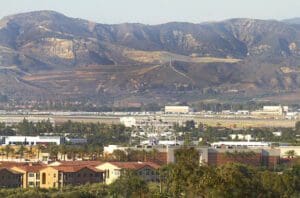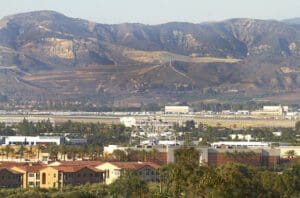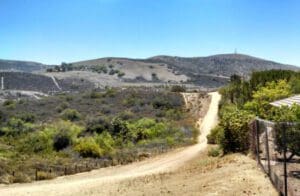Local History
North Tustin has a rich history which is largely forgotten. This page will add material as it is uncovered.
The Foothill Communities Association thanks The Tustin Area Historical Society for their agreement to share material from their archives for use on this website. The location is 395 South El Camino Real, Tustin. Hours of operation Tue & Thur 9:00 AM – 2:00 PM and the first and third Saturdays from 12:00 PM to 3:00 PM. (714) 731-5701.

Columns by Juanita Lovret
Juanita Lovret and the Tustin News have graciously given permission for us to post some of the very interesting historical columns written by Ms. Lovret for the Tustin News. More columns will be added periodically.
Incorporation Tustin

Tustin, when it incorporated 75 years ago this coming September, gave no indication that it would ever become the vibrant, successful community it is today. Barely 900 people lived within the small area now recognized as Old Town. Less than a third of the population had enough interest in incorporation to vote. Incorporation passed by 28 votes with 138 惣es’ and 110 ‘no.’
The newly elected mayor, Byron “Barney” Crawford; members of the first city council, Charles Logan, William Huntley, Edmund Kiser and Fred Schwendeman; city treasurer Walter J. Pollard and city clerk J. R. Harbour started from scratch. City offices were set up in borrowed space in the Knights of Pythias building.
Councilmen assumed specific duties. Kiser took charge of streets, walks and parks. Logan became fire and police commissioner. Huntley took over light and power. Schwendeman was responsible for health and safety. In December the city selected its first chief of police. Highly recommended by the city of Huntington Beach, John L. Stanton interviewed for the job and was hired immediately. Nicknamed “Big John” because of his 6�5″ height, he became a fixture at the corner of Main and D (El Camino Real). Seated in his car parked along the curb next to the side door to the drugstore, he kept an eye on traffic and mischievous kids until 1942.
The existing volunteer fire department continued to provide serve. Their fire truck, a converted 1912 Buick touring car donated by Sam Tustin, was housed at the Tustin Garage. Volunteers came on the run whenever the siren on the First National Bank building sounded. Eventually the fire department and city offices settled in a small stucco building on Third Street, but Tustin continued to operate with minimal staff and facilities. There were no full time firemen until 1962. It was 1974 before the city had a civic center complex with a city hall and police headquarters. A city treasurer and a city clerk are no longer sufficient staff. Tustin has added a city manager as well as numerous departments including finance, community development, business license, personnel services, public works, parks and recreation and redevelopment.
The police department has expanded from one man to hundreds of patrol officers, motorcycle officers and bike officers as well as plain clothesmen and K-9 units. Volunteer firemen have been replaced by professional firefighters from the Orange County Fire Authority.
The city now operates its own water department, contracts trash collection and disposal services, provides street sweeping and a myriad of other services not available to residents when Tustin incorporated in 1927.
Those 138 residents voting for incorporation really started something.
Juanita Lovret – A Brief Biography

Juanita Lovret has lived in the Tustin area for her entire life.
Her grandfather, Edward Spencer Jones, first came to the area in 1874. He and his bride, Maude Turner, bought property and set up housekeeping in 1885.
She began her journalistic career as an editor for Tustin Grammar School’s TGS Talkie, then worked for The Tustin News before entering Tustin High School and becoming a Broadcaster staff member and editor. She earned both a degree in journalism and a teaching credential at USC. Her career has been a mix of teaching, writing and editing. She taught at Tustin High in the early 1950s and the Saddleback College emeritus program at Leisure World for almost 15 years.
She has written “Remember When,” a weekly column for the Tustin News since 1997. A number of these Tustin memories have been reprinted in a book published by the Tustin Area Historical Society.
She was Tustin Woman of the Year for 1996 and is a past president of the Tustin Area Historical Society.
She and her husband, Clint, have three children who attended Tustin Schools and came back to the area after college. Her four grandchildren are the fourth generation to attend Tustin schools.
Tustin Water Works

The Tustin Water Works, now the water department of the City of Tustin, was established in 1887 and is the oldest business in Tustin. Charles F. and Hiram Willard, and Henry Adams formed Willard Brothers Water Works, utilizing an artesian well on the site which it still occupies on the corner of Main and Prospect. Planned to prosper with the boom of the late 1880s, the business faltered when the expected prosperity weakened.
After Adams left the firm, and his brother moved to Northern California, Charles Willard continued the losing venture. In 1897, he sold the business to his former schoolmate, C. E. Utt. Utt paid $2,000, a loss of $6,000 plus for Willard. The business reportedly lost money for the next 30 years. In Volume I, History of Orange County (Mrs. J. E. Pleasants, 1931), Utt writes, I, probably because I didn’t know any better, took over the business and have operated it for 35 years. During this period, it has increased from 50 customers to 800, or from a losing business to a fairly profitable one. This increase cannot be taken as a gauge of population growth. A large part of it is due to the extension of the mains to include new territory. Now the old Willard Water Works serves a territory as large as the city of Santa Ana with only about one-tenth the population. Utt changed the name to Tustin Water Works, drilled a new well and replaced the steam driven pumps with gasoline driven pumps. These changes cut his costs significantly.
The Utt family operated the water works for over 80 years. Stepson Walter Rawlings became superintendent and was in charge during Tustin’s post World War II growth. New equipment and replacement buildings maintained the efficiency of the company.
The City of Tustin acquired the water works in 1982. In addition to building an underground reservoir at the cost of nearly $9 million, the city has replaced the old buildings with new structures, using a style of architecture reminiscent of the 1900s. These house the well, pumps, generator and treatment plant. The well provides the new reservoir, which has 2.2 million gallon capacity, with 1,400 gallons a minute. The water works can produce 12% of Tustin’s total water needs each year.
The Willard brothers never dreamed Tustin residents would ever use 13 million gallons a day.
Orange Crate Labels

Although orange crate labels were once an important part of the citrus business, they are now important only to collectors. Growers such as Dr. William Burgess Wall, one of Tustin’s earliest with 40 acres of oranges and his own packing house by 1892, soon found the baskets and barrels customarily used to ship fruit were unsatisfactory for sending oranges east by railroad car. After some experimentation, they developed a wooden orange crate. Wooden orange crates were used until they were replaced by cardboard boxes in the ‘50s. Manufactured in a rectangular shape measuring 12 x 12 x 27, crates were easy to handle and could be quickly loaded into a rail car. Stenciled labels were used on the crates at first, but failed to appeal to the wholesalers who purchased the oranges. As a result, a colorful 10 x 11 inch label which attracted attention and promoted the product came into use.
Designed by commercial artists, most of these labels were produced in San Francisco and Los Angeles. Gordon T. McClelland and Jay T. Last, authors of “California Orange Box Labels,” estimate that there were 8,000 label designs. With adaptations this resulted in 15,000 different labels. McClelland and Last developed classifications for this vast number of labels.
The years from 1880 until after World War I are categorized as the naturalist period. During this time labels featured flowers, birds, animals and scenic views with a few historic themes. In 1920 labels began to stress the health benefits of oranges and orange juice. From 1930 until the mid-1950s when the cardboard box took over, label designs featured graphic art with more lettering than illustrations. Early labels were produced by stone lithography. Later photo composition and off set printing were used. Interestingly, few artists signed their designs.Orange crate labels gain value with age. When the cardboard box became popular, packing houses were left with thousands of unused labels. As collectibles these are available at a nominal cost. Since it virtually impossible to remove a label attached to a crate, labels from the early years are rare. For example, the Cal-Oro label used by Santa Ana Tustin Mutual Citrus Association in the 1920s (an excellent example of art deco with a vibrant butterfly against a black background) is cataloged at $150. Their Tustana label from the 1930s (a palomino stallion posed against a black background) is valued at $45.
The Tustin Area Museum (Tuesdays and Thursdays, 10 to 2) displays labels used by Tustin packing houses.
Santiago Peak

Early Tustin residents were awakened each morning by the sun rising over Old Saddleback, the peak that loomed above the entire Santa Ana Valley. Named by the early settlers for its saddle shape, Old Saddleback is really two peaks almost a mile apart in the Santa Ana Mountain range. Although the north peak is some 200 feet lower than the south peak which measures 5,691 feet, it is closer to the valley, creating the illusion that both are the same height.
Prior to being visited by a government survey team in the late 1800s, and officially named Santiago Peak, both the south peak and the chain of mountains had several names, according to Terry E. Stephenson’s book In the Shadows of Old Saddleback. The north peak remained nameless.
An 1801 map drawn by Don Pablo Grijalva identified the northern portion of the mountain range as Sierra de Santiago and the southern portion as Sierra del Trabuco, leading to speculation that the peak was called Trabuco. A map used by Don Teodosio Yorba in the early 1850s when he applied for ratification of his grant for Rancho Lomas de Santiago labeled the southern range Sierra de Santiago, suggesting the peak was called Santiago at that time.
Mexican vaqueros (cowboys) on the J. E. Pleasant ranch referred to the mountain range as Sierra de Santa Ana, possibly because of its relationship to the Santa Ana River. An 1861 geological survey named the 35 miles of mountains from the Santa Ana River on the north to San Diego County on the south, the Santa Ana range. The peak with its magnificent view of the entire Santa Ana Valley, distant mountain ranges, the Pacific Ocean and off shore islands, challenged early adventurers. In 1850 Major Horace Bell with a company of California state rangers and Mormon deputies from San Bernardino climbed it in search of a band of horse thieves. In 1861 state geologist Josiah Dwight Whitney and William H. Brewer made the ascent. Both parties referred to the south peak as Santiago. But when H. Clay Kellogg climbed in 1875, the peak was known as Temescal, a name still popular with residents living on the back side of the mountains near Lake Elsinore. Settlers in the San Juan Capistrano area and Trabuco canyon referred to it as Trabuco peak.
After the death of actress Madame Helena Modjeska in 1909, her friend Mrs. James S. Rice of Tustin campaigned to rename Santiago Peak in her honor. This was not possible, but the north peak was officially designated as Modjeska Peak. Although clouds, fog and air pollution frequently hide it from view, Old Saddleback is always there standing guard over Tustin.
David Hewes

Hewes House, Hewes Middle School, Hewes Avenue, Hewes Park —David Hewes left his mark on the Tustin area. But before he came to Tustin in 1881, he had achieved fame by providing a golden spike for the ceremony celebrating the linking of East and West by rail at Promontory Summit, Utah Territory.
Learning from Central Pacific Railroad President Leland Stanford that no commemorative was planned for the railroad’s completion, Hewes, a San Francisco contractor, took $400 worth of gold to Schulz, Fischer & Mohrig who cast a 5-5/8 inch long, 14.03 ounce, 17.6 carat spike and engraved on it. May God continue the unity of our Country as the Railroad unites the two great Oceans of the World, names of Central Pacific officials and The Last Spike. As it ended up, four spikes, not one and not all gold, were used during the ceremony on May 10, 1869. Newspaper owner Frederick Marriott commissioned a second gold spike inscribed with this spike the San Francisco News Letter offers its homage to the great work which has joined the Atlantic and Pacific Oceans, This month-May, 1869.
Nevada Railroad Commissioner F. A. Tritle ordered a spike forged from 25 ounces of silver. Arizona Territory Governor Anson P. K. Safford offered a 6 inch gold-and-silver-plated iron spike inscribed Ribbed with iron clad in silver and crowned with gold, Arizona presents her offering to the enterprise that has banded a continent and dictated a pathway to commerce. Presented by Governor Safford.
L. W. Coe, Pacific Express Co. president, ordered a maul from Conroy & O’Conner, silver plated by Vanderslice & Co., San Francisco. West Evans, tie contractor for Central Pacific, had San Francisco billiard table manufacturer Strahle & Hughes polish a California laurel tie drilled with four holes, and add a silver plaque engraved The last tie laid on completion of the Pacific Railroad, May, 1869. Traveling to the ceremony by private rail coach, Stanford carried The Last Spike and the ceremonial tie, and accepted the Nevada spike as his train passed through Reno. During the ceremony, Stanford placed California’s spikes in the first and fourth holes of the tie. Union Pacific vice-president Thomas Durant added Arizona and Nevada spikes. All were tapped in with the silver maul, then removed.
The Last Spike was returned to Hewes who donated it in 1892 to Stanford University to be displayed with the silver maul and eventually Nevada’s spike. Arizona’s spike is now in the Smithsonian. The 1906 San Francisco earthquake and fire destroyed both the commemorative tie and second gold spike. Replicas are displayed at the Golden Spike National Historic Site, Promontory Summit, UT. The ceremony is reenacted each May 10 and the second Saturday in August during the Annual Railroader’s Festival.
Here in Tustin a replica of the Golden Spike can be seen at the Tustin Area Museum.
City of Tustin



With the City of Tustin having passed the 75 year mark, it is important to know a little about the incorporation of the City of Tustin. Tustin residents voted on Sept. 14, 1927, to turn their village into a city with a mayor and city council. The vote was lukewarm, 248 citizens went to the polls to vote 138 to 110, but incorporation won. Byron Barney Crawford was elected mayor on the same ballot. He took office Sept. 23 and served over four years, until April 4, 1932. Elected along with Crawford, Fred L. Schwendeman, Charles F. Logan, W. M. Huntley and E. L. Kiser comprised the first City Council. They stayed in office longer than the mayor, Schwendeman until Jan. 4, 1937; Huntley, April 15, 1940; Logan and Kiser, April 21, 1942. To date, only one other councilman has surpassed Logan and Kiser in length of time served. Donald J. Saltarelli Jr. later served a total of 16 years.
The City of Tustin considers 1868, the year Columbus Tustin bought the property, as its founding. Historians, however, identify the filing of a plat map in 1870 as the community’s date of origin. The 100th anniversary of the founding of Tustin was celebrated in 1968. A round of celebratory activities was capped by renaming two streets. D Street, indicated by Columbus Tustin on his original plat map, became El Camino Real (King’s Highway), and Fourth Street was re-signed as Irvine Boulevard. It is important to note that this Fourth Street was the extension of the street by the same name in Santa Ana. Tustin’s original Fourth Street had become Main Street back in the 1800s as the little settlement began to grow.
Tustin has dozens of other milestones to celebrate. The first school opened in February, 1872. Tustin post office was granted on Oct. 28, 1872. Agriculture was firmly established when the Santa Ana Valley Irrigation company brought Santa Ana River water for irrigation to Tustin in 1877. The First Advent Christian Church is nearing its 125th anniversary, having organized on Dec. 5, 1880, and opening a chapel in 1881. Tustin Presbyterian Church also is on its way to 125 years, having opened its first sanctuary in 1884.
Columbus Tustin died July 27, 1883, and is buried with other members of the Tustin family in Santa Ana Cemetery. However, the town celebrates no Columbus Tustin day.
